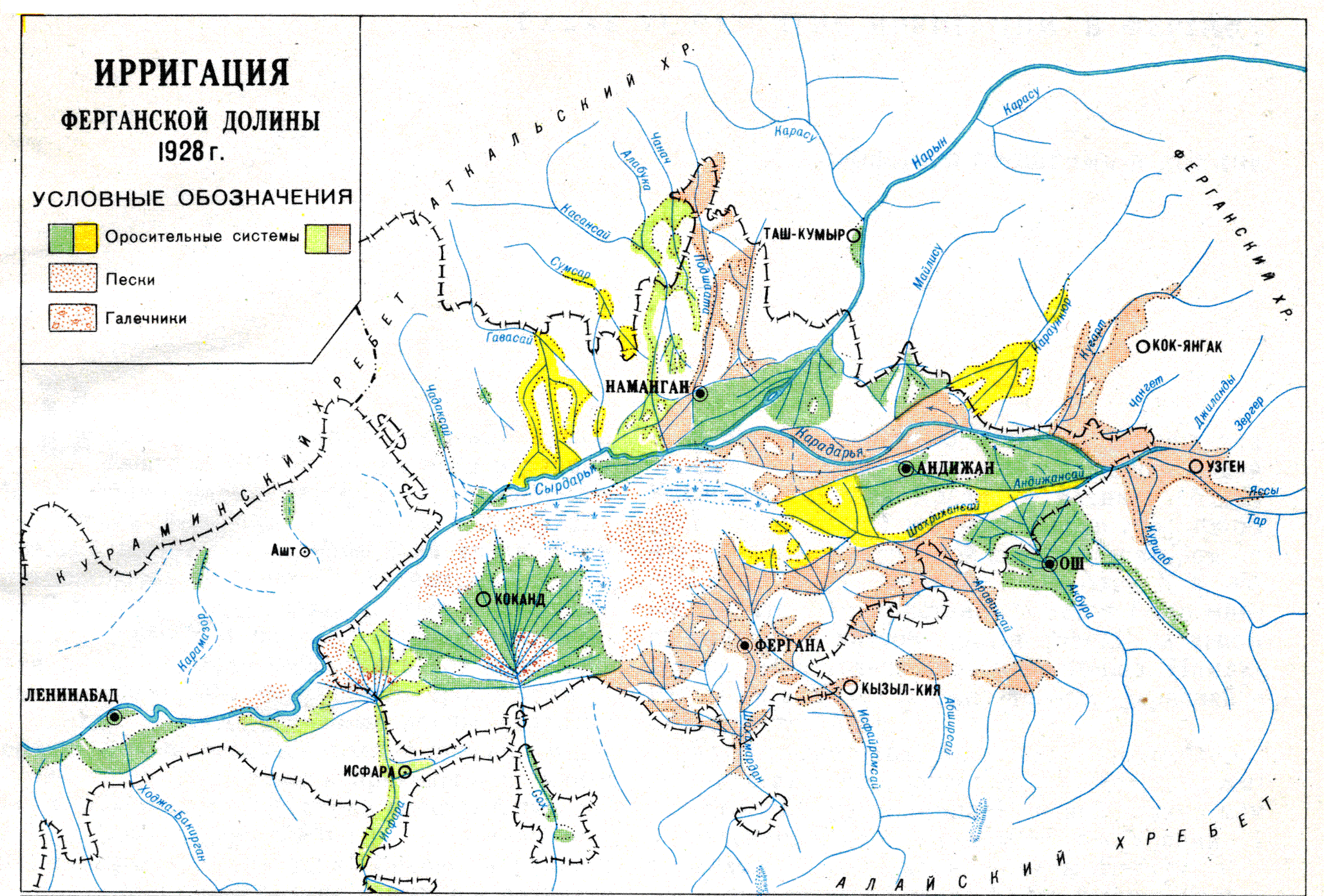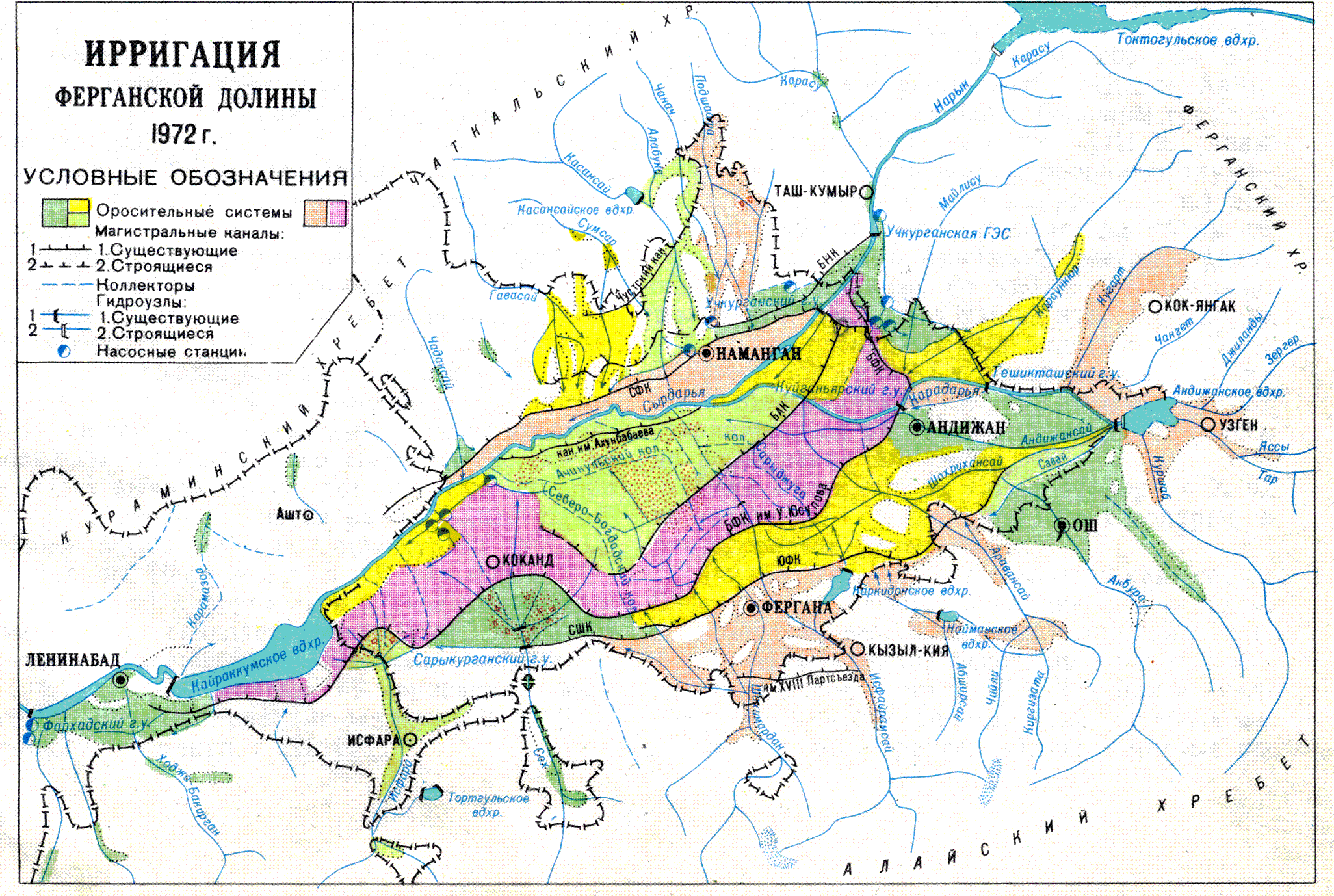Fergana Valley is one of the most ancient world oasis, where age of irrigation and development on this base of civilization as well as in India, Egypt, China, Middle East counts several millenniums. Archeological discoveries on its territory find first traces of so-called mountain-stream irrigation and first irrigation structures here corresponding to VI…VIII century BC (Bartold V.V., Andrianov B.V. et al.). Enormous intermountain depression crossed by Syrdarya River (Jaxartes or Oxus) with its two largest (Naryn and Karadarya) and numerous middle and small tributaries flowing down mountains towards main channel since olden times has been favorable place for people settlement, development of settled farming and ancient aborigines' culture.
| Social-economic significance of water management |
|
Water situation related to administrative division of Fergana Valley |
Since I century BC oasis has attracted many conquerors, beckoned them, sometimes it let them conquer itself, however, invisibly over time it has ground, swallowed strangers in its heart, absorbed elements of their innovations. Nevertheless in general it remained specific great, developed farming region with own culture, traditions, and agrarian production practice, associated crafts and way of life. Alexander Makedonsky found just such a region and established near present Khojent his eastern capital - Alexandria Eskhata, just from here, ancient Andijan, culture and traditions of "The Great Moguls", which had been initiated by talented Babur, penetrated in territory of world cradle - India. Plenty of water sources, favorable conditions for water diversions gradually have created ramified canal network based on headwork structures without dam and difficult enough, but strict order and sequence of water use and allocation. In spite of changing structure of governmental management of tribal arrangement of khanates, sometimes subjected to power of such powerful leaders as Alexander Makedonsky, Chingiz-Khan, Timur, traditional water management system by means of institution of mirabs, arykaksakals, community water use with tested for centuries regulations persisted unchanged and constantly operating. Even tsarist government dealing hard with Turkestan colonization since 60-ies of XIX left some traces in city construction as of new - Skobelev (Fergana) with their rectangle planning, and so old - Kokand, Andijan, Uzgen, Osh, in creation of first engineering structures in water management, but decided to retain traditional water management structure. According to evidence of Russian economist Shakhnazarov (1908) "ordinary water right in Turkestan was supported by community as more reliable water use basis than state agriculture".
By the beginning of Soviet era Fergana Valley as irrigated oasis (fig.1) represented set of ring irrigation systems located on removal cones of the biggest Syrdarya River tributaries Sokh, Isfara, Isfairam-Shakhimardan, Andijan, downstream Naryn, Akbura, and Aravan with recharge from these rivers, between which great massifs of undeveloped lands of Central Fergana were located. Low water availability of these systems was typical.Since the end of 40-ies Soviet state initiated big-scale works on changing water supply system of Fergana Valley. The purpose was established to create at the expense of engineering water intakes construction on rivers Naryn, Syrdarya, and Amudarya network of canals circling valley from two sides, connecting Syrdarya River tributaries' basins and simultaneously balancing water availability of all irrigated lands. Canals Savay, Big Fergana Canal, South Fergana Canal, North Fergana Canal as well as Akhunbabayev's Canal, Big Andijan Canal, and Big Namangan Canal have been constructed. Already in 1985 main land reserves of Fergana Valley were almost totally developed (fig.2). Irrigation characteristic of Fergana Valley lands is given below in dynamics of 1930…2000 years and prospective over countries.
Irrigation characteristic of Fergana Valley lands
Territory |
Reclaimed area |
Available for irrigation |
Irrigated over years, thousand ha |
Fallow lands |
||
|
1930 |
1970 |
2000 |
||||
|
Fergana Valley |
9053 |
1539 |
6100 |
1066 |
13100,9 |
163,1 |
|
Kyrgyzstan |
6408 |
341 |
162 |
214 |
330,7 |
10,3 |
|
Tajikistan |
699 |
197 |
39 |
97 |
133,9 |
63,1 |
|
Uzbekistan |
1946 |
1001
|
474 |
1005 |
911,3 |
89,7 |
Soviet era was signified not only by gigantic reconstruction and transformation of all irrigation network to engineering one famous by its unprecedented Big Fergana Canal construction scales and rates, and then - whole set of dams, water reservoirs, and water intakes: Kompyrravat and Farkhad hydrounits, complex Kairakkum, Andijan, and Toktogul reservoirs along with hydroelectric station and set of structures as well many dams on tributaries, but also breaking of these traditions. It introduced strict principles of centralized coordinated water resources management and irrigation executed by public services managing and supervising water resources hard from republican centers and financed at the expense of budget up to down, because even agricultural entities being finite water use in maintenance and development of onfarm irrigation network mainly were based on public financing. Herewith most complex and expensive hydro-reclamation complexes were erected with account for national expediency and benefit, not orienting on payback abilities of primary farms-water users themselves. Other serious disadvantage of that era was ignoring environment interests and, especially, mutual irrigation impact at different gypsometric levels on ground water-table rising, wetting and salinization. Chase of irrigation development after 1970 was accompanied by development of high valleys, adyrs under complex conditions of water-lift, increased erosion ability that, finally, caused necessity of additional reclamation works, which complicated system and increasing its operational costs more.


All these consequences and disadvantages emerged in water management and irrigated agriculture of Fergana Valley after USSSR collapse. Three independent sates - Kyrgyzstan, Tajikistan, and Uzbekistan as well as rest Central-Asian countries in connection with economic potential decrease, breaking of economic relations and simultaneously lack of subsidies from federal government parallel with permanent decrease of purchase prices for cotton - main crop of region, couldn't properly maintain materially and financially this most complex water system that immediately effected several results. First of all, agricultural producers' incomes were reduced rapidly as well as their ability to maintain former agricultural network in former state. Enough to say that if in 1970 agricultural production in Uzbek part of valley on area 690 thousand ha was 712 million rub. in 1965 prices or 1031 rub/ha (1840 USD/ha), in 1990 it was reduced up to 700-800 dollars/ha, and presently it is only 650$/ha. Secondly, governmental costs for network maintenance were reduced - if till 1990 on 1 ha of irrigated area on average 130 rub/ha (232 USD) were spent, presently on average 54$/ha were spent, as given below, of which power cost rapidly increased in price - 50%! This caused decrease of system manageability, increase of losses mostly unproductive and organizational as well as sharp reduction of ability to deliver water to irrigated lands. Weakening of personnel, different reorganizations in independent states resulted in water economic potential loss and inability to manage and even obtain information on old forms and parameters.
Insufficient and unstable water availability of finite users in 1930 came back again, but already loaded by big luggage of created and operated hard capital stock.
These historical premises, on the one hand, explain reasons of Fergana Valley network design scheme complexity, and on the other hand - emergence of those subjective and objective reasons, which currently make impossible water management and irrigation in old way - command-administrative method - providing this work successfully before.
World practice, and partially, practice within region itself, leads to necessity of transition to integrated approach of water resources management that would mostly eliminate those barriers and disadvantages, which are existing today in this aspect in Fergana Valley.